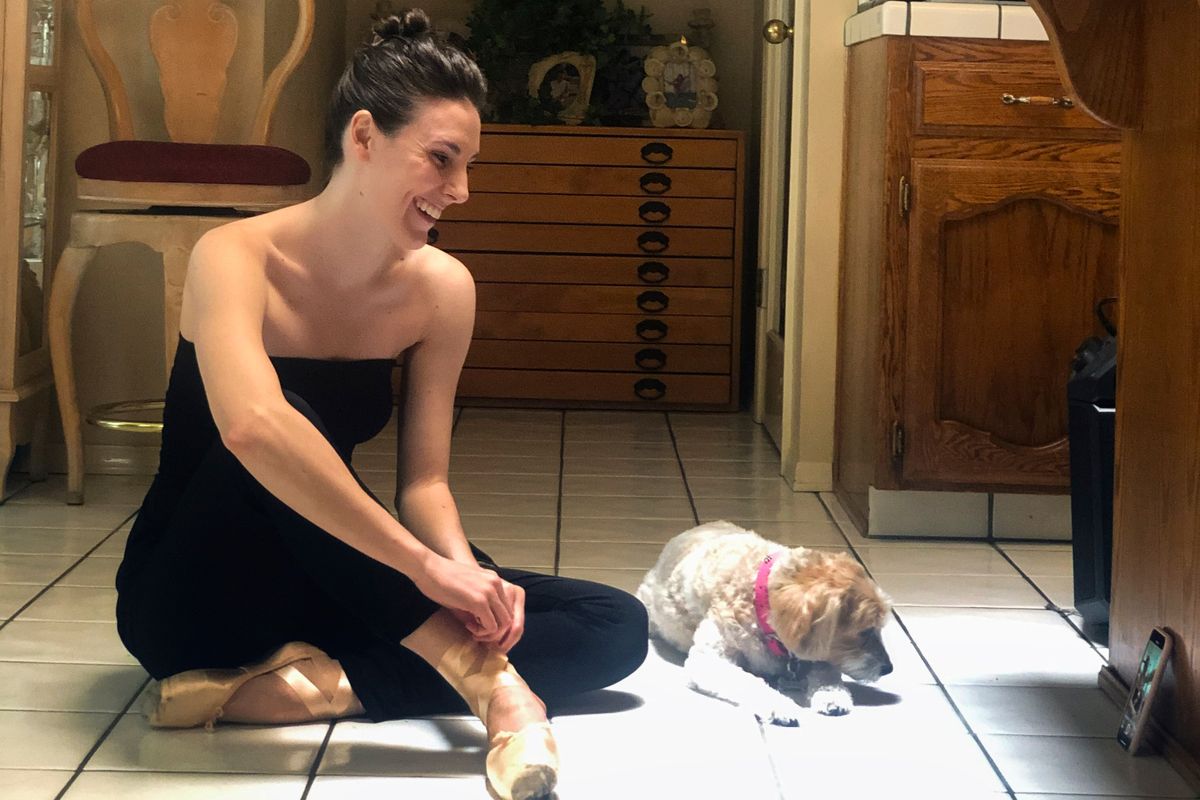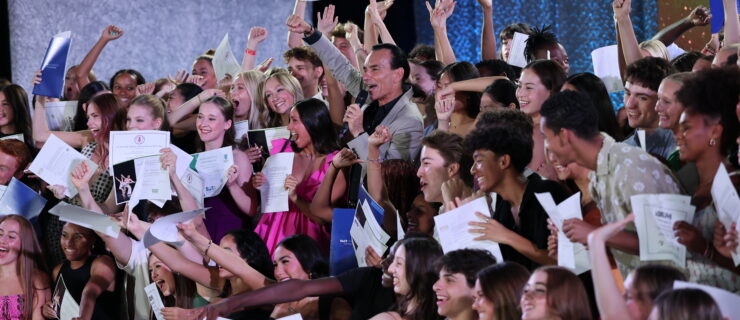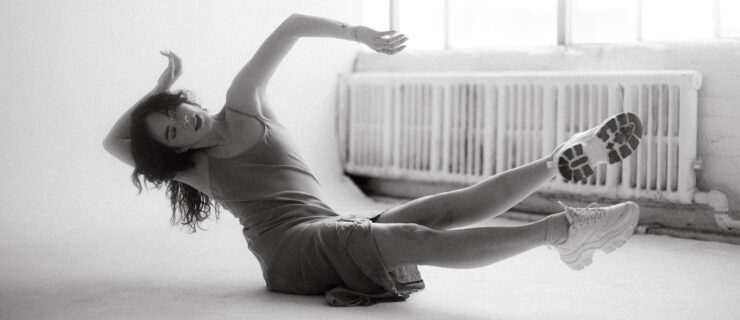Tiler Peck's Top 10 Tips for Training at Home
On March 15, New York City Ballet principal Tiler Peck announced to her 172,000-plus Instagram followers that she’d be teaching a live class from her family’s home in Bakersfield, California, where she’s currently waiting out COVID-19. Little did she know that she’d receive such a viral response. Since then, Peck has offered daily Instagram LIVE classes Monday through Friday at 10 am PST/1 pm EST, plus an occasional Saturday class and Sunday stretch/Pilates combo. “The reaction was just so overwhelming,” she says. “These classes are keeping me sane, and giving me something to look forward to.”
Now, well over two weeks since most in the U.S. have gone into self-isolation to prevent the spread of the virus, Peck’s classes are just one of many online dance offerings. But they continue to garner high attendance, with dancers tuning in from all corners of the world. Peck encourages students to share their progress with the hashtag #turnitoutwithtiler, and in just the past few days has received videos from Ireland, Australia and Brazil, with followers ranging from young kids to pros to people picking up ballet again after a 15-year break. “It’s so motivating to do this together, even though we have to be at home,” says Peck.
But we all know that taking class at home comes with its own set of challenges: How to find a barre? What to wear? When is pointework safe? We caught up with Peck by phone to hear all of her best tips for training at home.
1. Location
Have you found yourself wandering around your home, wishing a barre would miraculously appear? While Peck’s been teaching class from her kitchen counter, she says that finding the right barre substitute has everything to do with your height. “The most important thing is that you don’t have your shoulder up, or can’t do things because you’re in a weird position,” she says. “Some people might have lower kitchen counter tops, so a chair might work better.”
2. Floor
The last thing anybody wants right now is to hurt themselves while dancing on a slippery floor, and unfortunately not everyone has access to a portable square of marley. Peck says to be mindful of the type of shoes that you’re wearing. “I use leather shoes, so the tile floor is fine for me,” she says. “I just tell my dad not to wash the floor until after I teach class, because it gets too slippery.” If you’re wearing canvas shoes, Peck recommends doing barre, or practicing turns, on carpet instead.

Courtesy Peck
3. Pointework
Pointework is a whole other can of worms. Peck limits her class to include just 15 minutes of pointe to stave off injuries. “Try a carpet for pointe, unless you’re holding onto a barre,” she says. “Relevés are good, both two legged and one legged. And échappés, and bourrés.” Be very careful about attempting pirouettes on pointe on a slick floor. “They might be better to try on carpet.”
4. Jumping
We’ve all been told countless times about the risks of jumping on hard floors. But Peck has come up with two solutions. “When I need to work on my jumps I go in the backyard,” she says. If going outside isn’t an option right now, Peck has an inside fix as well. “Put a yoga mat down on the hardwood floor, so there’s a little cushion,” she says. “When I was coming back from my neck injury and jumping was the hardest for me, I always jumped on a yoga mat, even in my pointe shoes.”
5. Clothing
While it can be temping to roll straight out of bed and hop onto Instagram, Peck believes that creating distinction in your day is crucial. “I definitely think you should put your hair up, and get out of your pajamas,” she says. “It doesn’t have to be a leotard, but tight clothing that makes you feel that this time is different than just watching TV is important. You want to be able to really see when your knee is straight, and baggy pants don’t really do that justice.”

Courtesy Peck
6. Music
In hard times, it’s important to find fun where we can. Peck regularly likes teaching to classical music, to keep her classes focused, but she does mix it up a few times a week to bring a little joy to her students. “One day a week I add in pop music, because I feel like we need some light during such a crazy time,” she says. If you’re looking to give yourself class at home, Peck’s suggestion is to find classical instrumental versions of pop songs, which she finds easily on Spotify. “I think that’s a good balance,” she adds.
7. Navigating People
Ideally, we’d all have an interrupted hour to take class each day. But part of this new world order is learning to navigate shared spaces with family and roommates. Peck’s suggestion is to come up with a schedule. “My parents know that from 10 to 11 I get the living room,” she says. “My class is at a set time each day to make that easier for people.” Nevertheless, Peck has learned to be patient when interruptions happen. “Sometimes my dad will come in to wash his hands while I’m teaching, and I just joke about how he’s practicing good hygiene.”
8. Corrections
Peck has found that the trickiest part of live classes is that she can’t see her students, and so can’t correct them in real-time. As a solution, she gives as many preventative corrections as possible while teaching, and urges students to listen closely. “I’m constantly talking about things I know people are probably doing wrong, saying knees over toes in pliés and stuff, so that when they hear me they’ll fix it.” She also responds to dancers who share videos using the hashtag #turnitoutwithtiler. “They’re really surprised that I write so many corrections to them, but I feel like I’m getting to pass on this knowledge to so many more people that I would have in a physical studio.”
9. Nutrition
With our routines interrupted, it can be hard to figure out healthy eating patterns throughout the day. “I’m so close to the kitchen!,” jokes Peck. She’s found that eating snacks about every three hours works for her, rather than big meals. “The best thing my physical therapist ever told me is that half an hour after you work out you need protein,” she says. “I tend to make a chocolate shake, or have some chocolate milk.”
10. Wellness
While daily class helps keep our bodies healthy, thinking of wellness holistically is more important than ever. Peck is focused on getting enough sleep, and keeping her immunity up with a Vitamin regimen recommended by NYCB physical therapist Marika Molnar. “My entire family is taking Vitamin C, Vitamin D3, Selenium, Zinc and Magnesium every day,” she says.
Peck also suggests mitigating social media use. Last week the Peck family went old-school, and sat down for a game of Monopoly. “As much as this time is hard and difficult, I’m getting time with my parents and sister and grandma that I feel like I’m going to cherish forever,” she says. “That’s what’s helping to keep my mind healthy.”




